Looking back into the coffee history could take you some time. Coffee has crossed many stages throughout history to reach us in our time and be a basic drink in many daily lives. This article will explain the myths and facts that revolve around the origin of coffee and the stages that it has gone through since its discovery until almost 2 thousand years later in 2023.
Where Did Coffee Originate?
Historians failed to reach a consensus about when and where coffee was discovered. Many myths indicate that the discovery of the berries began in Ethiopia; however, everyone agreed that Yemen was the beginning of the spread of coffee to the world.
Let us clarify the most famous myths circulating about coffee’s origin and how it turned from those red berries on a tree into a cup of joe.
The Legend Of Kaldi The Goatherd
The most famous legend of how the coffee was discovered goes back more than a thousand years. The story goes as follows, in the 9th century, an Ethiopian goatherd named Kaldi found that his goats got more energetic after eating red berries from an unknown tree.

Kaldi tried the berries himself and found that it gives him the same energy. So he went to share this discovery with his local monastery monk, but the monk did not allow their use and threw them into the fire. A fantastic aroma emanated.
This aroma aroused curiosity for other surrounding monks. The experiments conducted after this incident led to the first coffee cup.
The Legend Of Sheikh Omar
Sheikh Omar was Sheikh Abu al-Hasan ash-Shadhili’s disciple. He was famous for his healing powers. Omar was banished from his community for unknown reasons to a cave in the desert. Hungry and desperate, Omar ate the red berries from a nearby bush but, he found it bitter.
Keen on making the most out of his meager meal, Omar roasted the beans, ground them up, and boiled them with water. It was producing an energizing brown liquid that sustained him for days.
The Legend Of Ghothul Akbar Nooruddin
Another legend is related to the Yemeni Sufi mystic Ghothul Akbar Nooruddin. On his trip to Ethiopia, he noticed some birds in the sky have become very energetic after consuming a strange plant’s berries. So he went and tried it, to find himself also more attentive. Ghothul returned with this magical discovery to Yemen and spread it among the people.
Suppose you are not convinced of these myths and want the real written history. In that case, I will take you on a journey around the world, starting from the Middle East to Asia and America, to discover the stages that coffee went through to reach us with all the shapes we know today.
The Middle East
When did people start drinking coffee? The recorded history of coffee away from the myths begins in Yemen, where coffee was used as a drink by Sufi Muslims to help them focus at night.
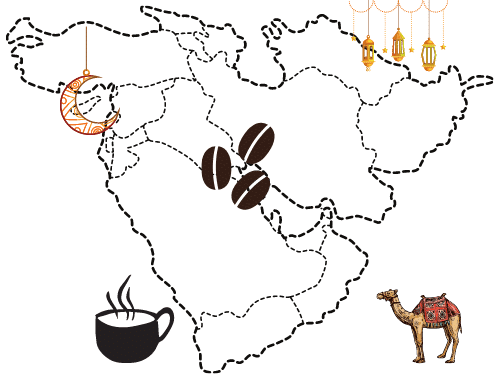
Coffee was exported through the port of Mocha in Yemen, which immensely helped spread coffee around the world. Then coffee traveled north, and by the year 1414, coffee drinking had become widespread in Mecca and Medina.
After a while, coffee culture traveled to Egypt and North Africa. It was used widely in cities such as Cairo, Damascus, and Baghdad during the Mamluk state. With the spread of people’s love for drinking coffee, coffee houses became the place for men to gather, entertain, talk, and hear poetry.
At the end of the Mamluk state and the beginning of the Ottoman Empire, coffee houses increased in Cairo and Aleppo, Syria. In the year 1554, it reached the Ottoman capital, Istanbul.
For more than 200 years, The Ottoman Empire monopolized the coffee trade. They boiled and roasted the coffee beans before exporting them to prevent them from being cultivated outside their lands.
Prohibition Of Drinking Coffee
Drinking coffee has been banned more than once throughout history due to people’s lack of understanding of the nature of its effect or ideological and political reasons.
In 1511 drinking coffee was banned in Mecca due to its effect on people, and this ban lasted for 13 years before it was lifted in 1524. Drinking coffee was also prohibited in Ethiopia by the Ethiopian Orthodox Church in the 18th century. This ban lasted for more than a century.
The 16th Century
The 16th century marks the era when coffee became popular in the Middle East, Persia, and other parts of Turkey.
The Middle East was the place where coffee shipped to Italy and from there to the rest of Europe. Then the Dutch were the reason for the spread of coffee to the Americas.
Yemini tried to secure coffee production, but they failed. However, the Dutch attempts to smuggle live coffee beans succeeded. They begin to grow plants in their own country and modern colonies in Sri Lanka and Java. Then they focused on the production and began to spread coffee by trade in places like Japan.
What Is The Origin Of The Word Coffee?
The word “coffee” crossed three stages to enter the English language. Initially, coffee is an Arabic word that pronounces “Qahwah”. When coffee was introduced to the Ottoman Empire, it became “Kahve”, then the Dutch called it “Koffie” which became “Coffee” in English in the 16th century, specifically in 1582.
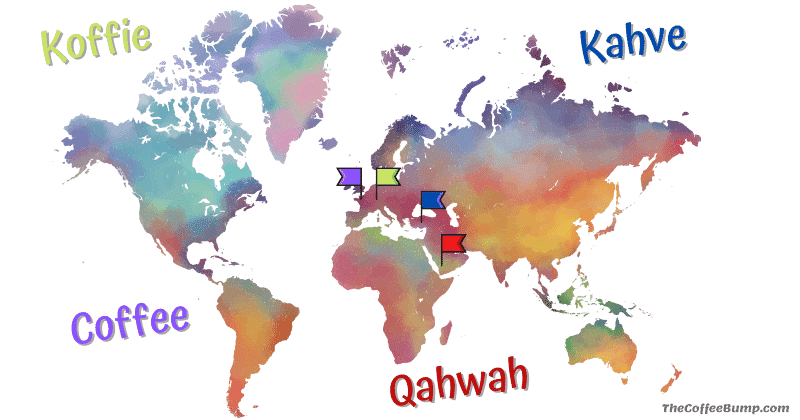
Europe
The first encounter with coffee in Europe was in Malta during “the Great Siege of Malta” in 1565. The Muslims that were imprisoned by the Knights of St John during the siege used to make their favorite drink.
At the beginning of the 17th century, the Dutch smuggled coffee beans to be cultivated in their country. Still, they failed because the coffee plant could not be grown in a cold climate. Also, the discovery of coffee beans brought by the victorious European troops who plundered the Ottoman camps contributed to the spread of Vienna’s siege. Coffee was declared a Christian drink and quickly spread throughout Europe.
Coffee became a hot commodity in Europe during the 1600s, and many business companies focused on importing it. Coffee Houses opened in 1645 on the mainland of Europe outside the Ottoman Empire and Malta.
To shed some light on your cup of coffee, one of the most exciting coffee historical instances happened in the 1700s. Coffee at that time was consumed in small bowls, which is why handles were soon developed for these bowls in Europe. This allowed holding the handle of your coffee cup as you leisurely consumed your coffee.
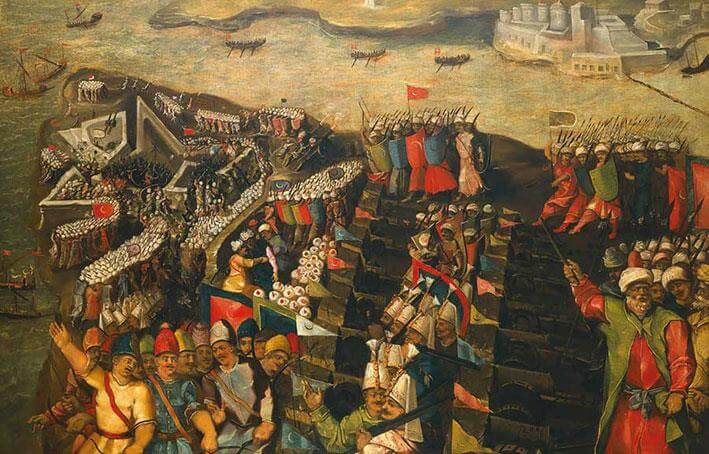
Asia
Coffee entered Asia through India first in the 17th century when Baba Budan, on his return journey from Mecca through Mocha’s port in Yemen, smuggled a few beans of coffee. When he returned to India, he planted it in Chandragiri Hills, which later named after him as “Baba Budan Giri”. After that, coffee cultivation was expanded in the south and other places in the highlands of India.
At the end of the 17th century, when Indonesia was a Dutch colony, coffee was grown in places such as Jakarta, Sumatera, and Java. Indonesia was considered at that time the main engine for the spread of the export of coffee through the Dutch.
Coffee cultivation was one of the main factors contributing to the development of the infrastructure for roads and railways in the 19th century in Indonesia. These roads contributed to the transport of coffee from the center of the islands to the ports exported to Europe and America.
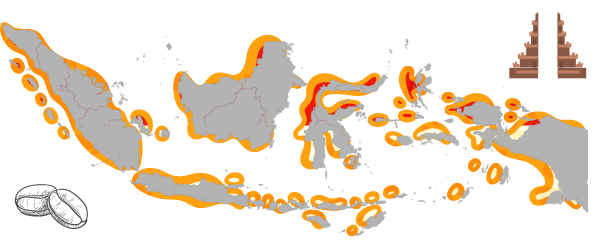
Indonesia used to grow Arabica. At the end of the 19th century, a large part of the coffee crop on Java Island was affected by Coffee rust, which stopped coffee export for a long time. To deal with it, the Dutch cultivated Robusta instead of Arabica, representing around 90% of the coffee industry in Indonesia.
In our current time, Indonesia is considered the third-largest producer of coffee in the world. In other countries in Asia, the Dutch were responsible for the spread of coffee, such as Japan and Indonesia.
USA
As we illustrated before, coffee started to spread from Yemen centuries ago. It soon made its way through the Arabian Peninsula into Europe, finally reaching the US.
The first person to bring coffee to the new world was Captain John Smith, founder of Virginia, and that was in 1607 but, it wasn’t as famous as it was in the East at that time. Drinking tea was the most popular choice at the time.
When Did Coffee Become Popular?
Drinking coffee was not popular in the USA until the famous “Boston Tea Party” protest on December 16, 1773. At this protest, the price of tea taxes imposed by Britain made the angry protestors dump a tea shipment into the harbor brought by the British East India Company.
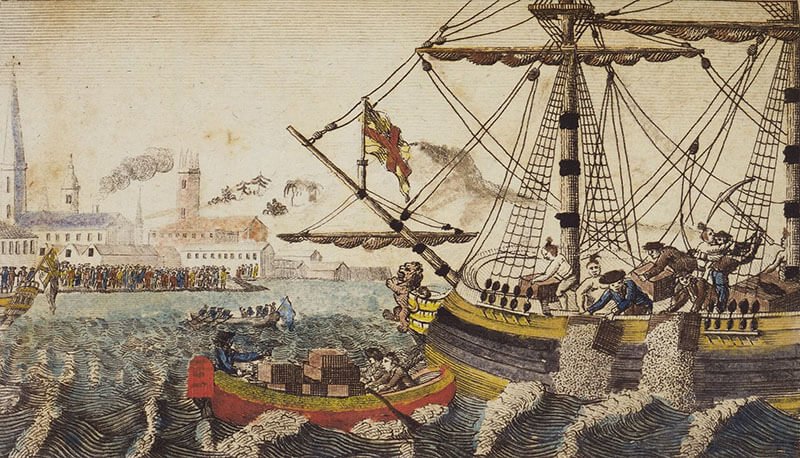
After that, switching from drinking tea to coffee became a patriotic duty. source
5 Major Events That Changed History
Once coffee set sail to America, five notable events changed the practice of coffee drinking as we know it today:
- 1670 – Deep in Boston’s heart, Dorothy Jones was granted a license to become the first official American coffee trader. Wahoo! Coffee trading began with a bang.
- 1773 – The good, old Boston Tea Party made it unpatriotic to drink tea. As a result, coffee gained a foothold amongst tea drinkers. Several taverns started to serve coffee as makeshift “coffee houses.”
- 1861 – The Civil War began, and soldiers took coffee rations with them to the battlefields. Coffee popularity climbed.
- 1920-1930 – Soldiers returned to the US from World War I. They were so addicted to their newfound coffee habit from military rations that coffee houses grew by 450% in the US.
- 1971 – You knew this was coming. Starbucks was introduced in 1971, spurring the birth of specialty coffee houses across the nation.
In the 70s and 80s, coffee became increasingly popular in the US because of percolators’ marketing. This was a device that everyone wanted to have in their own home, but it turned out that it was not so easy to use to make a simple brew.
From there, people moved on to the gratification of instant coffee because it allowed them to have a cup of Joe in just a few seconds. Countless instant coffee brands popped up on the market at that time to satiate consumer demand, including several multimillion-dollar marketing campaigns to fight out who was the best of the best in instant coffee producers.
This instant appeal is what made room for the many coffee houses that remain popular today. This is precisely why so many American coffee drinkers are willing to stand in a Starbucks line for up to 15 minutes to get a quick latte or cappuccino made to their liking.
Where Did The Term “Cup of Joe” Come From?
It is so easy to take for granted this handy little term. Still, it’s pretty interesting to think about where it originated. When you think back to World War II, you may recall that the US military men were called GI Joes, and they also happened to be big coffee drinkers.
Soon, the two terms became synonymous, so coffee was only known as a cup of Joe. And it has stuck with us over the years to be just as popular today!
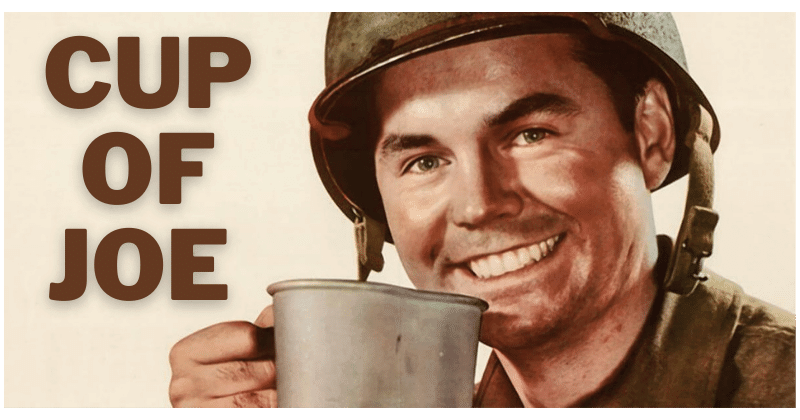
Specialty Coffee
Before we wrap up the rising history of America’s favorite drink, we can’t forget how specialty coffee has shaped the present coffee industry. Before Starbucks opened its doors in 1971 and turned specialty coffee on its head, specialty coffee appreciation began to grow in the 1960s.
The term “specialty coffee” was first used in the Tea & Coffee Trade Journal in 1974.
Why was the 1960s such a pivotal time in the specialty coffee industry? To answer that question, you’d have to ask the post-World War II Baby Boomers. As the Baby Boomers came of age in the 60s, many were looking for a bohemian outlet to challenge the previous generation’s traditions. Local cafés and coffee shops provided the perfect place to gather, chat, perform live music and poetry, and create a real counterculture.
You may be familiar with Peet’s Coffee & Tea, established in 1966. Owned by Alfred Peet, a.k.a. the grandfather of specialty coffee, Peet’s became a trendsetting specialty coffee company that operated right out of Berkeley, California. Peet’s encouraged introducing artisan coffee roasting styles that local customers (cleverly called Peetniks) welcomed with open arms.

As luck would have it, two major Peet’s fans also happened to be Seattle coffee enthusiasts and the creators of Starbucks: Gordon Bowker and Jerry Baldwin. Starbucks opened in 1971 selling specialty roasted coffee beans only; in the 1980s, Howard Schultz took the company mainstream to open the first Starbucks coffee shop modeled after the laid-back Italian café culture.
Fast-forward to the present, and specialty coffee is still alive and kicking. Even more so, the specialty coffee industry supports the mainstream coffee industry with more and more micro-roasters popping up each year.
Whether you prefer your coffee black with no frills or served up as a half-caff skinny venti mocha, one thing is for sure: Coffee isn’t going anywhere. The rich, robust American coffee culture has something for everyone and continues to attract new converts every day.
Important Milestones In The History Of Coffee
Coffee has a deep and dark history, but there have been different trends that have contributed to coffee’s popularity in the past few decades. Before we jump the gun and talk about how coffee has risen in demand, let’s explore some events that left a mark in coffee history.
The Spread Of Coffee Houses
Coffee houses have been around for centuries, and people have been using them to read, socialize, and make business decisions, as they still do today.
One of the first coffee houses was said to pop up in the 1500s in the Middle East. It became increasingly popular because the only last place for people to meet was the pub. By the 1800s, there were known to be over 600 coffee houses in England, though the King did try to ban the brew at the time.
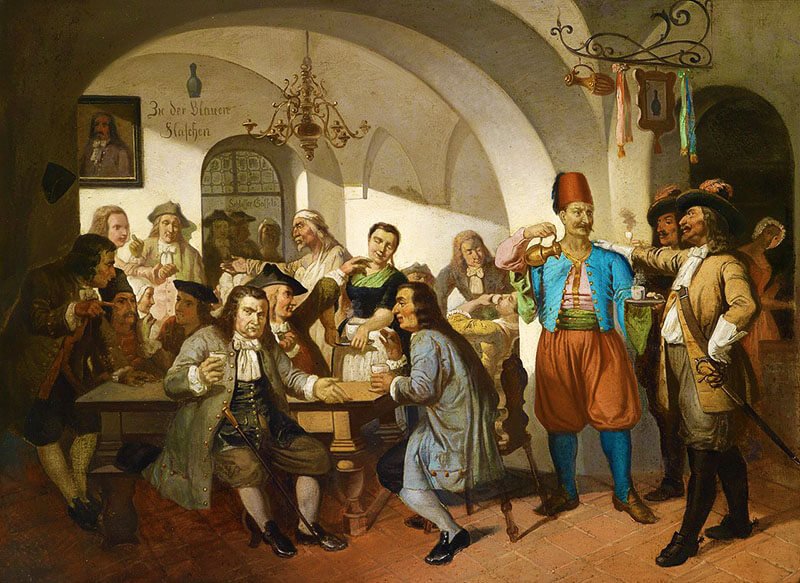
From there, coffee houses began to sell a variety of wares, such as tea, tobacco, and chocolates. You could see people using the coffee house to relax or even make political moves in those times. The coffee house has not changed much in my estimation. It is humbling to think that this same establishment was actually the location that the fathers of our country could have made their decisions.
The Invention Of The Coffee Machine
Before the spread of coffee in Europe, preparing a cup of coffee was done straightforwardly. Water is added to the coffee grounds in a pot or, as the Turkish call it, “cezve” or “Ibrik” with sugar and left on the stove till it boils.
Away from the famous Turkish method, the French introduced the infusion brewing method: to put coffee grounds in a linen bag, put it in boiled water and let it infuse.
The infusion method was not all the French had to offer. In the late 18th century, Jean-Baptiste de Belloy, was the first man to invent a technique that did not depend on boiling water by introducing the first drip brewing machine.
Jean-Baptiste de Belloy invented the first percolator, which was called “without boiling water” and his method was later known as “French drip”.
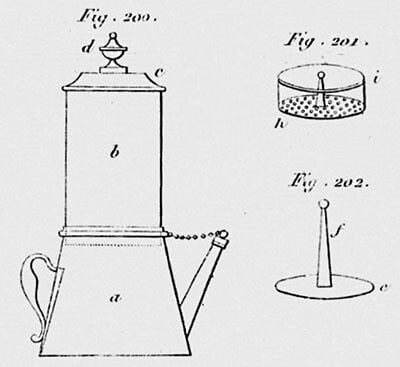
In the same century, many other inventions were introduced, such as the Napoletana or flip pot, the siphon pot, and several modifications were made to the initial Belloy’s design.
For more information about coffee from seed to cup visit our coffee 101 article.
The First Espresso Machine
After the spread of coffee in Europe, inventors and investors looked for a way to reduce people’s waiting time in coffee houses to brew their coffee cups.
Espresso came from Italy. The first attempt to make the steam-based coffee machine was by Angelo Moriondo in 1884. He was awarded the bronze medal in his hometown of Turin for this invention. Moriondo patented his invention but did not sell it commercially. Instead, he used it exclusively in some of his cafes at the time.
In the early 1900s, Luigi Bezzera introduced many modifications to this model, such as adding coffee filters and multiple group heads. He registered several patents in 1901 and 1902. But he sold the rights to his patent in 1905.
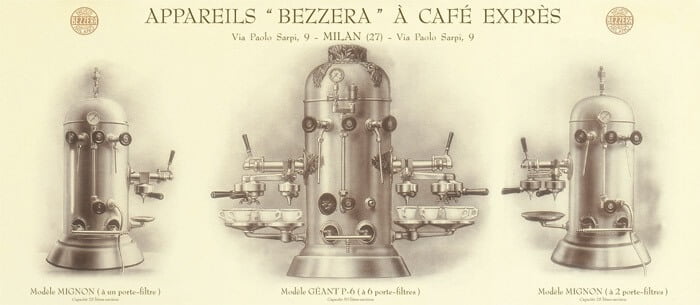
Though the patent for the machine was bought by Desidero Pavoni sound familiar? He is the creator of the famous La Pavoni line of espresso machines. Still, he made some adjustments to the original idea. He was the first to manufacture the machine on a massive scale. Pavoni also made modifications to the previous model, such as adding a pressure release valve, which was not present before, and he even added the steam wand in the same machine.
In 1933 the first automatic machine was created by Francesco Illy. This machine was the cornerstone of today’s espresso machines.
The Invention Of Instant Coffee
The origin of the discovery of instant coffee is not clear enough. But the first patent was registered in France in 1881 by Alphonse Allais.
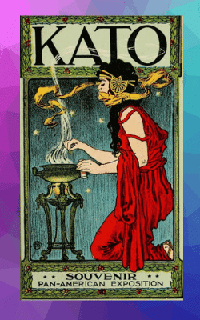
This was followed by the registration of another patent in 1890 in New Zealand by David Strang. Before these patents appeared to the public, it was believed that the first inventor of instant coffee was a man called Satori Kato, who registered his invention in 1901 in the USA.
Another famous inventor was George C.L., Washington. G. Washington Coffee Company became famous during the First World War for mass-producing instant coffee.
In 1938 Nescafé introduced its famous product, which was a significant transformation in the instant coffee industry.
Updated for 2023.
FAQ
What Is The Origin Of The Coffee, Yemen, or Ethiopia?
The definitive answer to this question depends on your ability to accept myths. The origin and date of coffee discovery are summarized in some tales that may be fictional. Therefore, it is impossible to determine the origin of coffee. Still, the written history indicates that Yemen was the first to use coffee as a drink and exported this idea to the whole world.
When Was Coffee Invented?
Myths tell us that the discovery of coffee was in the 9th century. Still, real history indicates that the 15th century was the beginning of our knowledge of coffee and the beginning of its spread from the Middle East to the world.
Who Invented The Espresso Machine?
The first attempt was in 1884 by Angelo Moriondo, followed by Luigi Bezzera in 1901 with his modifications to the previous model, then the first to mass-produce it was Desidero Pavoni in 1905.
Where Did The Word Espresso Come From?
Along those lines, the first espresso machine was named the Fast Coffee Machine. When you translate fast in Italian, it is “espresso,” and thus, the Espresso Machine was born.
When Did Coffee Come To America?
Coffee reached the United States at the beginning of the 17th century by Captain John Smith. The first license to sell coffee was granted in 1670 but, the real spread of coffee in America began in the 18th century after the famous “Boston Tea Party”.
Who Is The Inventor Of Instant Coffee?
For a long time it was believed that the inventor of instant coffee was the American inventor of Japanese origin Satori Kato. But it appeared to the public that two patents were registered, one in 1881 in France and the other in 1890 in New Zealand. These two patents refer to converting coffee into a powder that boiled water is poured over to turn it into instant coffee.






